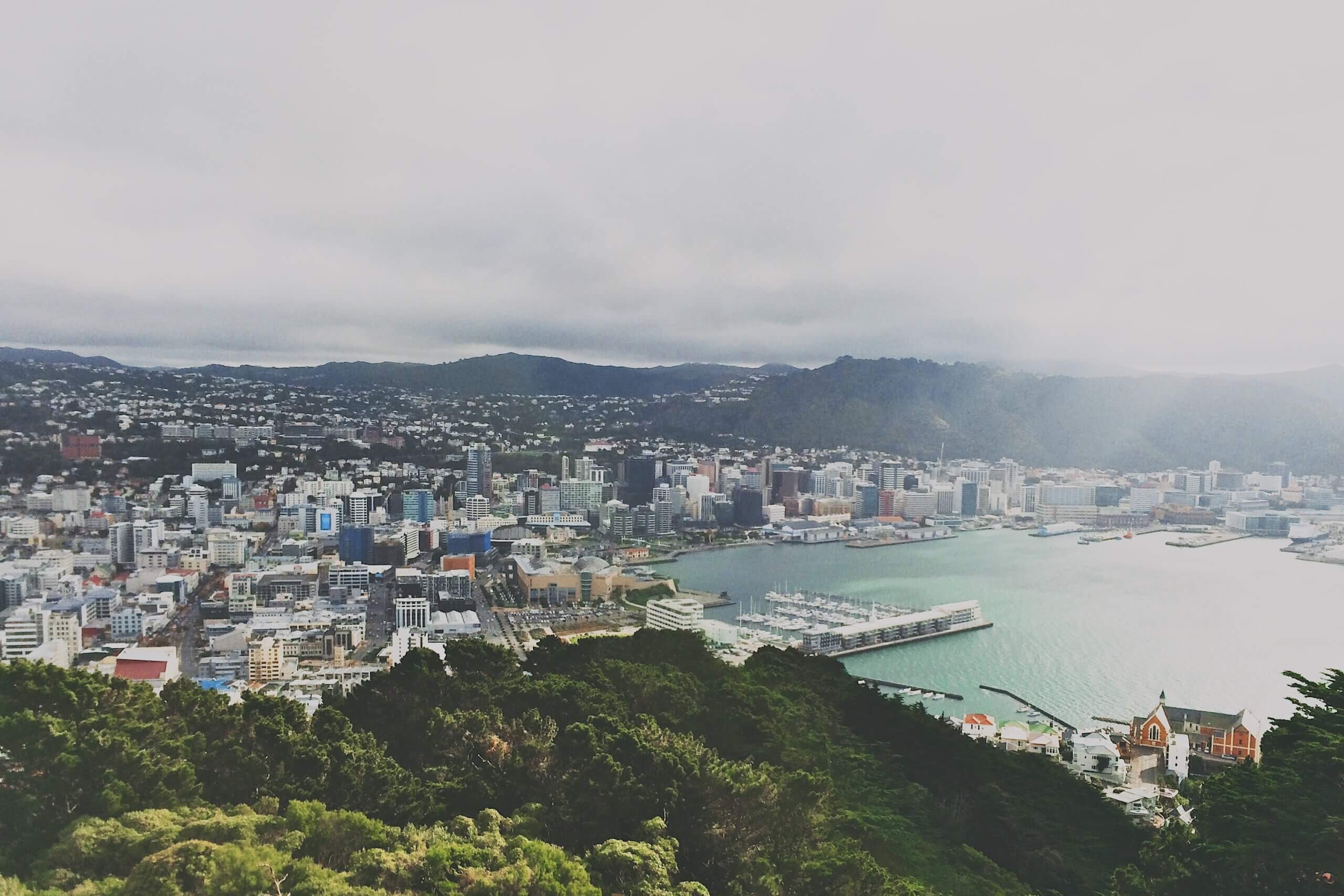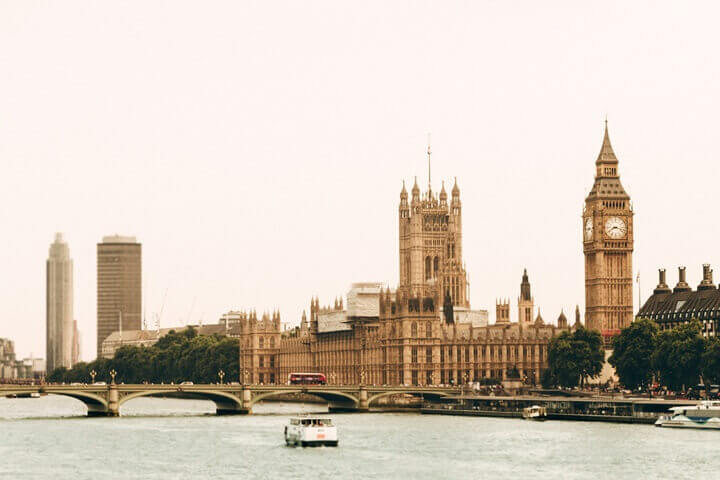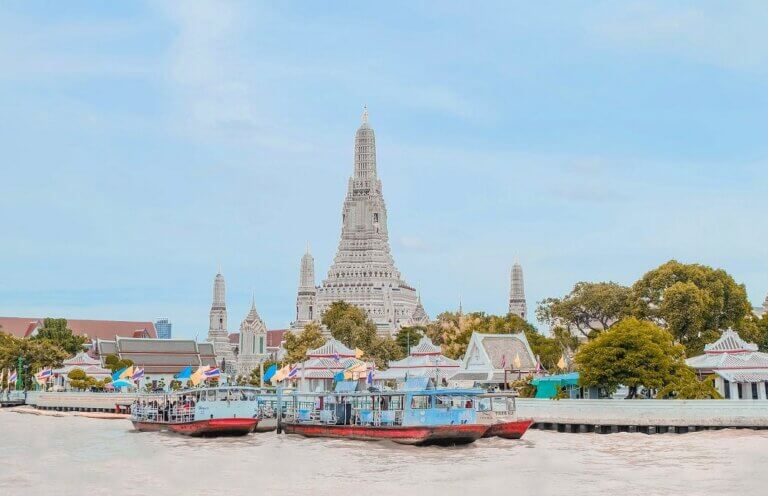24 Hours in Bangkok: The Ultimate Itinerary
Only have 24 hours in Bangkok? This itinerary will help you make the most of your time in this bustling metropolis.
The Thai capital is one of the most visited cities in the world. International visitors flock there for its cultural attractions, delicious cuisine, vibrant nightlife, and excellent shopping. To top it all off, Bangkok delivers all these experiences at a reasonable price.
Unfortunately, one day is not enough to get to know this city well. Bangkok is vast and getting from one place to another can take some time. However, with the right planning, it’s possible to see some of Bangkok’s most popular attractions in just 24 hours.
I’ve been fortunate to visit Bangkok multiple times, and each time I discover new aspects of this city. From exploring its historic neighbourhoods and sites to tasting Bangkok’s famous street food and visiting its epic malls, there really is a wealth of things to do.
This 24-hour itinerary in Bangkok covers the city’s most iconic historic sites and offers opportunities to taste delicious street food. Don’t be surprised if, after spending just one day exploring the city, you start dreaming about your next visit there.
Disclosure: Some of the links below are affiliate links, which means that at no additional cost to you, I may earn a small commission if you click through and make a purchase. Please note, I only recommend products and services that I know and love. Read full Privacy Policy here.
24 Hours in Bangkok: The Ultimate Itinerary
This one-day itinerary in Bangkok is perfect for first-time visitors to the Thai capital. You’ll spend the morning and early afternoon exploring the city’s most famous cultural sites in the historic Rattanakosin Island area. Then, you’ll switch gears and ease into a relaxing evening enjoying street food and the city’s contagious nighttime energy.
8.30am – The Grand Palace

We’ll start the day nice and early to beat the crowds and the heat. The first stop on this itinerary is one of Bangkok’s most famous attractions: the Grand Palace.
This striking historic complex was established in 1782 and served as the official royal residence for the Thai Royal Family until the early 20th century. The compound includes living quarters, halls, pavilions, government buildings, and temples, all enclosed by protective walls.
The opulent architecture of the Grand Palace beautifully combines Thai and Western styles. As you explore the complex, you’ll encounter intricate carvings, mosaics, complex murals, sculptures and elegant tiles that reflect the high level of craftsmanship involved in the creation of this stunning site.
The Grand Palace is not only a symbol of secular power but also an important religious site. It is home to the Temple of the Emerald Buddha (Wat Phra Kaew), which houses a unique Buddha image entirely carved from a single block of jade. Many Buddhists travel from across Thailand to this temple to pay their respects.
Entry to the Palace is 500 baht (15 USD) per person. You can pre-book them online or buy them on the day of your visit. There is a dress code, so you’ll need to wear clothing that covers your shoulders and knees. Alternatively, you can buy a sarong at the entrance.
You can learn more about this stunning historic site on one of these tours:
11.00 – Wat Pho
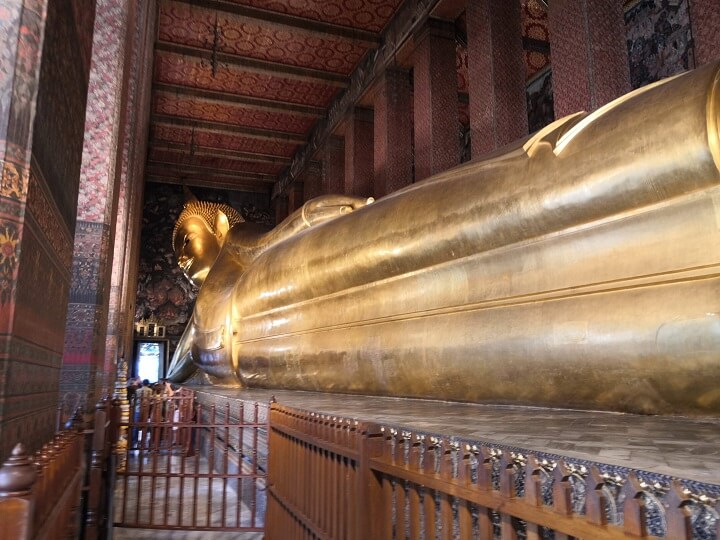
Just a short walk from the Grand Palace is another iconic historic site: Wat Pho. Founded in the 16th century, this religious complex is the oldest in Bangkok.
The most famous feature of Wat Pho is the giant reclining Buddha, housed in one of the temple buildings within the complex. This impressive figure is covered in gold leaf and measures 46 meters in length and 15 meters in height.
You can walk around the reclining Buddha image to appreciate its scale, but I also recommend exploring other parts of the Wat Pho complex during your visit. The site features stupas, intricate murals, quiet chapels, and over 1,000 Buddha statues. Since most tourists primarily visit the Reclining Buddha, you’re likely to find many quiet corners in other areas of the complex.
Wat Pho is also home to a traditional Thai medicine and massage school. If you’d like to take a break from exploring, this is a great place to experience traditional Thai massage. A massage session can last either 30 minutes or an hour, depending on your preference. Be sure to factor this into your itinerary.
Entry to Wat Pho is 200 baht (6 USD) and includes a complimentary bottle of water. A modest dress code is in place, so you’ll need to cover your shoulders and knees here as well.
1.00pm – Lunch
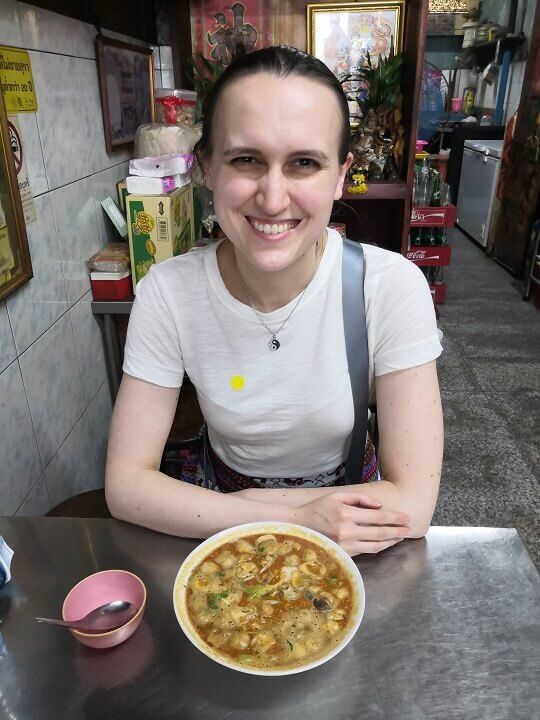
After a morning of exploration, it’s time to recharge and refuel. Fortunately, you’ll find plenty of dining options near the Grand Palace and Wat Pho, making it convenient for this itinerary.
A variety of eateries line Maha Rat Road, offering everything from Thai street food to modern, air-conditioned cafes that serve Western food. Given that you have only 24 hours in Bangkok, I recommend using this lunch break to try some delicious Thai dishes.
Simply pick a spot along this road that catches your eye and enjoy a delicious meal. While some places may appear quite basic, equipped only with a fan and lacking English menus, these are often the places serving the most authentic dishes.
2.00 – Wat Arun
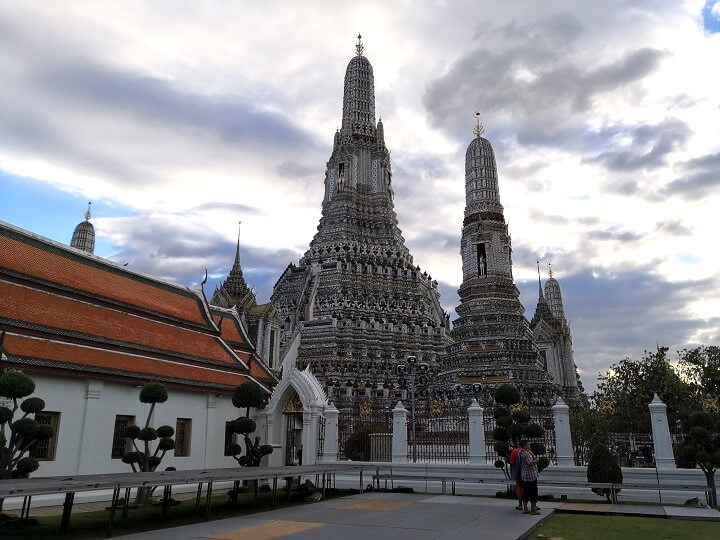
The next stop on this itinerary is the striking Wat Arun, the Temple of Dawn. It is located just across the river from the Grand Palace and Wat Pho and is easy to get to.
The two sides of the Chao Phraya River are connected by a frequent boat service. Just head to the The Tha Tien Pier a 5-miute walk away from Wat Pho and pay 4 baht (0.12 USD) for the crossing. Just a short journey later you’ll be at Wat Arun.
Wat Arun boasts a unique architectural design featuring a striking 70-meter Khmer-style spire. The temple is clad in intricate Chinese porcelain mosaics that are laid out in complex floral patterns. These mosaics glisten beautifully on a sunny day.
The temple complex is not big, but you can climb the central spire part way to enjoy great views over the surrounded area. Just a word of warning, the stairs are incredibly steep, so take extra care on both ascent and descent.
Entry to Wat Arun costs 100 baht (3 USD) per person. There is the same modest dress code as there is at The Grand Palace and Wat Pho.
4.00pm – Chinatown
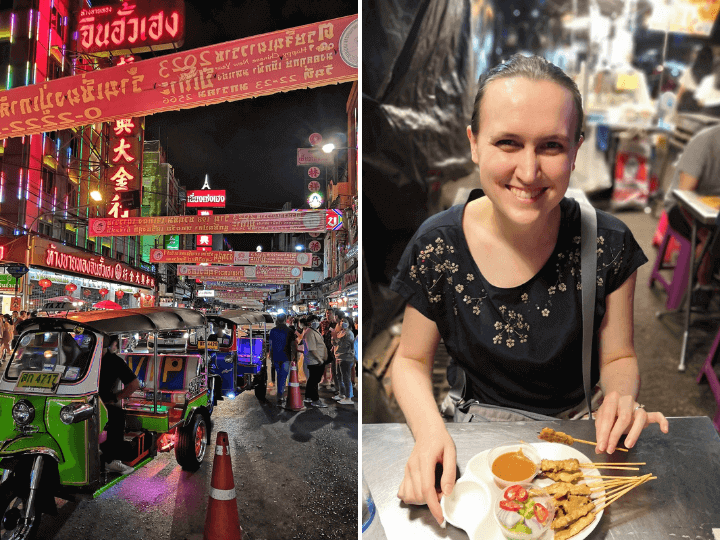
Chinatown is one of the city’s most iconic neighbourhoods, and it’s a must-see even if you’re only spending 24 hours in Bangkok.
To get there from Wat Arun, consider taking either the Chao Phraya Express or the Chao Phraya Tourist Boat to Ratchawong Pier, which is just a short distance from Chinatown. During the trip, you’ll have the opportunity to enjoy picturesque city views and take in Bangkok’s vibrant river life.
Bangkok’s Chinatown is one of the largest in the world, established in the late 18th century as Chinese communities began settling there. Over the years, it has transformed into a bustling commercial hub, featuring markets and shops that sell everything from traditional Chinese medicine to clothing and religious amulets.
While in Chinatown, make sure to explore its historic alleyways, where you can discover artisan workshops, intricate Chinese temples, and trendy bars. The neighbourhood brims with character, thanks to its unique fusion of Thai and Chinese cultures.
However, most visitors flock to Chinatown primarily for its extraordinary street food. In the evening, Yaowarat Road, the area’s main thoroughfare, becomes a bustling corridor of street food vendors offering a wide variety of culinary delights. To get a true taste of the area, try dishes from multiple vendors.
With so many culinary options, it’s easy to get overwhelmed. If you’d like some expert guidance in the world of street food, check out this Chinatown food tour. This guided experience allows you to try over 16 dishes while learning about the intriguing history of this vibrant neighbourhood.
9.00pm – Rooftop Bar near Chinatown
As our 24-hour journey through Bangkok draws to a close, you’re likely to be exhausted from a day packed with exploration. If you’ve still got some energy left, though, why not cap off the day with a cocktail at a rooftop bar?
Bangkok boasts a wide array of rooftop bars scattered throughout the city. Since your final stop on this itinerary is Chinatown, consider the Grand China Princess Hotel Rooftop Bar which offers panoramic city and river views.
If you’d rather return to the city’s historic heart where your day began, you could enjoy a cocktail while taking in the illuminated Wat Arun temple. Both the Rooftop Bar at the Sala Rattanakosin Hotel and the Eagle Nest at Sala Arun are excellent options for this scenic experience.
Another popular nightlife destination in the historic area of Bangkok is Khao San Road. Known for its popularity with backpackers, it’s the go-to spot for an affordable, albeit somewhat tacky, night out.
If you have a few extra days in the city and are curious what the fuss is all about, it might be worth a visit. However, if you only have 24 hours in Bangkok, you won’t miss out on anything if you skip it.
When is the Best Time to Visit Bangkok?
Cities like Bangkok are year-round destinations, but some seasons are better suited for city exploration than others.
November to March is Thailand’s dry season, offering the most sunshine and low humidity. This period is also the ‘coolest’ part of the year, with average temperatures hovering around 27°C (80°F). It’s the best time to explore historic attractions, which often lack air conditioning.
The downside of visiting during this time is that it’s also the peak tourist season. Accommodation and flight prices are generally higher, especially in late December and early January when many people around the world are on holiday. Popular attractions can also become quite busy.
The hot season begins in late March and continues until June. April is the hottest month, with average temperatures rising to 30°C (86°F). Although humidity only starts to rise in May, the heat can feel quite oppressive when exploring the city on foot.
Bangkok’s rainy season runs from July to October. During this time, the city experiences high humidity and significant rainfall. This is typically the low season for tourism, but the rainy season might offer some great deals on accommodation and tours for those looking to stretch their travel budget further.
How to Get to Bangkok
Visitors can travel to Bangkok by air, rail, or coach, depending on their departure point. However, most people traveling from overseas will likely arrive in the city at one of its two international airports.
Bangkok’s main hub for international and domestic flights is Suvarnabhumi Airport (BKK), which is well-connected to the city by public transport. Travelers can use either the bus network or the train to get to their destination.
Public buses are the most affordable way to get to and around the city. You can expect to pay about 35 baht ($1 US) per person for a trip from the airport to your city destination. More information on bus routes is available here.
Train fares range from 15 to 45 baht, depending on the distance travelled. For the most up-to-date information on train fares, timetables, and routes, visit the Bangkok Airport Rail Link page.
The other, smaller airport serving Bangkok is Don Mueang Airport. Like Suvarnabhumi, Don Mueang is connected to the city via bus and rail links. Additional information on these transport options can be found on the dedicated bus page and train page.
Another option for getting from either Bangkok airport to the city is to take a taxi. If you’d like to avoid the hassle of sorting out transportation upon arrival, you can pre-book your transfer via Welcome Pickup. It’s an easy and transparent way to arrange your transport.
How to Get Around Bangkok
One of my favourite things about Bangkok is that it is quite easy to get around, thanks to the many transport options available. The city has a reputation for horrid traffic jams, so hiring a car is generally not recommended.
Here are a few transportation options that you are likely to encounter most frequently on your next visit.
Taxi
Bangkok taxis are pretty much ubiquitous and are relatively affordable for overseas tourists. They offer a comfortable and convenient way to travel, although it might not be the most efficient option during rush hour.
Getting a taxi in Bangkok is straightforward – you can simply hail one on the street. The driver will often suggest a flat-rate payment for the trip. However, these rates are often highly inflated.
To achieve the best rate, tourists are advised to ask the driver to turn on the meter. However, the driver can simply refuse to do so and leave. In all my trips to Bangkok, I’ve never managed to get a driver to turn on the meter. Luckily, even the inflated price is so low by Western standards that it doesn’t bother me too much.
Also, once you pay, make sure that you receive the correct amount of change. Unfortunately, taxi drivers may pocket extra money if you’re not careful.
Grab
In all honesty, dealing with taxi drivers in Bangkok can be a bit of a hassle. Thankfully, there is an alternative in the form of a ride-hailing app called Grab, which is Thailand’s version of Uber.
This app works much the same way as Uber and allows you to get a taxi or a private car ride quickly and easily. The best part is that you will know in advance how much you will pay, reducing the need to haggle.
You can pay via the app by connecting your card details before your journey, or with cash at the end of the trip.
Tuk-Tuk
Tuk-tuks are motorised rickshaws that are also readily available as a transportation option in Bangkok. They are a bit of a tourist attraction in their own right, but locals also use them for short trips.
Just like taxis, tuk-tuks are easily found in tourist areas. Drivers often congregate near hotels and in popular neighbourhoods such as Chinatown and Khao San Road. You can simply approach one to request a ride.
Tuk-tuks are relatively inexpensive, but be sure to agree on the price before your ride. Normally, drivers charge tourists a higher price. Feel free to haggle to reduce the proposed fee. You will probably still end up paying more than a local would, but the cost is generally quite low.
Tourist Boats
One of my personal favourite ways to travel around Bangkok is by boat. You have two major boat options to choose from: the Chao Phraya Express or the Chao Phraya Tourist Boat.
Both offer similar routes that stop near popular attractions like the Grand Palace and Wat Arun, although the Chao Phraya Express has a more extensive route.
Bangkok looks fantastic from the water, especially at night. Additionally, traveling by boat means you won’t be stuck in traffic and can enjoy a bit of a breeze, which is ideal in a tropical city.
BTS Skytrain
Although the BTS Skytrain is a great public transport option in the city, you’re unlikely to use it if you’re closely following this 24-hour Bangkok itinerary. Nonetheless, I’m including it in this article, so you know it’s available.
The BTS Skytrain is an elevated train network that primarily covers Bangkok’s business district, the more modern part of the city. It features clean, air-conditioned carriages that make travel a pleasure.
Traveling by BTS Skytrain is relatively inexpensive for tourists. However, many locals find the cost of using this mode of transport too high. The latest information on ticket prices and routes is available on the BTS Skytrain website.
Underground Train (MRT)
Another great transport option in Bangkok is the MRT, the underground train network. The MRT is modern, comfortable, and convenient. It also has wider coverage of the city compared to the BTS Skytrain, connecting the modern and historic parts of Bangkok.
The MRT features two lines: the Blue Line and the Purple Line. You can find stops within easy distance of the attractions on this itinerary, including the Grand Palace and Chinatown.
To find out more about the routes and train fares, visit the MRT website.
Bus
The most affordable, but probably less comfortable and convenient way to get around Bangkok, is by bus. However, this mode of transportation is often preferred by locals, offering the most ‘authentic’ transport experience.
The Bangkok bus network features over 100 routes that connect the city centre to the suburbs. You can find complete information on routes and timetables on the Bangkok Mass Transit Authority website.
Be prepared for the fact that many of Bangkok’s buses don’t have English signage and are often not air-conditioned. They can get overcrowded, and some drivers may be quite careless. However, bus fares start from just 8 baht ($0.23 US), so they are incredibly cheap.
In general, most tourists prefer to take other forms of transport while in Bangkok, but this option is available for you as well.
Where to Stay in Bangkok
Bangkok offers an extensive range of accommodation choices, spanning from budget-friendly hostels to luxurious hotel chains. If you’re planning to spend around 24 hours in Bangkok and would like to follow the itinerary outlined here, I recommend staying in the historic Rattanakosin Island area, where most of the attractions on this itinerary are located.
Here a few great options to choose from:
- Budget: The Royal ThaTien Village
- Mid-range: Sala Rattanakosin
- Luxury: Riva Arun Bangkok
For more information on the local neighbourhoods, check out this guide to the best areas to stay in Bangkok.
Tours and Experiences in Bangkok
Here is a selection of fun tours and experiences to book for your next trip to Bangkok.
Final Thoughts
Hope you’ve found this 24-hours in Bangkok itinerary helpful. You may feel that it’s quite full-on, especially in the heat, so feel free to adapt it to your needs.
As I’ve mentioned before, one day is simply not enough to see everything the city has to offer. So you might as well take your time and explore the parts that interest you the most.
If you have more time in the city, check out our 2 Days in Bangkok itinerary. It includes additional experiences that will make your trip to the Thai capital unforgettable.
Those looking to combine a trip to Bangkok with a visit to Phuket should check out this guide to Thailand’s most popular beach destination. This island has something for everyone, including solo travellers, couples and families.
FAQs: 24 Hours in Bangkok
One day is not enough to make the most of everything that Bangkok has to offer. However, if extending your trip is not an option, it is still possible to visit the city’s most famous sites in just one day.
I recommend spending between 3-5 days in Bangkok. This should give you enough time to see a few famous attractions and explore different neighbourhoods. You can easily spend even more time there if you wanted to.
If you only have a small amount of time, it is best to stay close to the attractions that you are planning to see. For this one-day itinerary in Bangkok, I recommend staying in the Rattanakosin Island area where the Grand Palace and Wat Pho are located.
Enjoyed this guide on how to spend 24 hours in Bangkok? Bookmark or pin it for later.
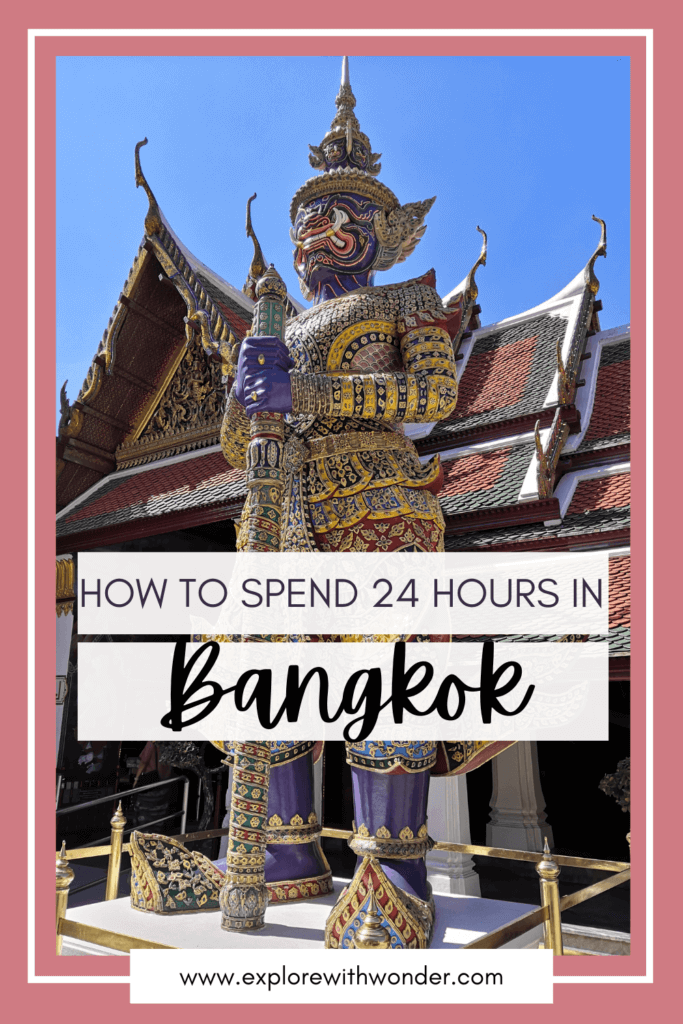
Related Reads: Thailand
- Is Thailand Worth Visiting in 2024? 17 Best Reasons to Visit Thailand
- What is Thailand Famous for? 23 Things You Need to Know
- Why Is Thailand So Cheap? Cost of Travel to Thailand in 2024
- Is There Uber in Thailand in 2024? Everything You Need to Know
- Does It Snow in Thailand? Everything You Need to Know
- Phuket or Bangkok: Which Should You Visit?
- Best Areas to Stay in Bangkok in 2024
- Is Bangkok Worth Visiting in 2024? 17 Best Reasons to Visit Bangkok
- Is Phuket Worth Visiting in 2024? 10 Reasons to Visit Phuket
- 2 Days in Bangkok, Thailand: The Definitive Travel Itinerary
- Where to Stay in Phuket for Couples: The Best Areas and Hotels
- Phuket in December: Everything You Need to Know in 2024


